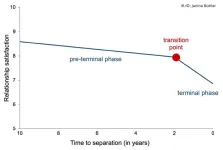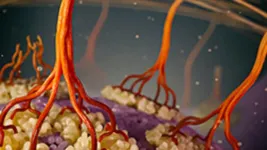(Press-News.org) March 19, 2025 — Today, the Obesity Action Coalition (OAC) and The Obesity Society (TOS) sent a letter to the U.S. Food & Drug Administration (FDA), along with more than 20 leading organizations and providers across the healthcare continuum, urging the agency to enforce federal regulations around compounding following the recent resolution of GLP-1 medicine shortages. Among the signatories include: the Alliance for Women’s Health & Prevention, the Association of Black Cardiologists, the National Hispanic Medical Association and the National Consumers League.
The letter follows recent announcements from the FDA that Eli Lilly’s tirzepatide, marketed as Zepbound for weight loss and Novo Nordisk’s semaglutide, marketed as Ozempic for diabetes and Wegovy for weight loss, are no longer in shortage. In addition, a federal court in Texas recently declined to issue an injunction blocking the FDA’s tirzepatide decision – underscoring the “ceasing” of all copycats by compounders.
Following the recent resolution of GLP-1 shortages, we applaud the FDA’s clarification issued last week for GLP-1 compounders which indicates that outsourcing facilities making versions of tirzepatide have until March 19 to cease operations. Pharmacies must stop compounding semaglutide by April 22 while larger outsourcing facilities have until May 22, or until the district court rules on a pending injunction in the district court case – what comes first will take precedence.
The letter also acknowledges that U.S. regulations permit some compounding pharmacies to produce versions of brand-name medications under limited circumstances, including when they are in short supply or where necessary to meet the individualized needs of a specific patient. However, continued mass-production compounding of GLP-1s, in the absence of a shortage, undermines the regulatory framework designed to protect patients from potential risks associated with unapproved and unregulated drug formulations.
To address this issue, the signatories urge FDA to take the following action:
Enforce Existing Regulations: Ensure that compounding pharmacies adhere to federal regulations by discontinuing the production of GLP-1 medications now that the shortage has been resolved.
Monitor Compliance: Implement measures to monitor and enforce compliance during and after the grace period to prevent unauthorized compounding of these medications.
Educate Stakeholders: Provide clear guidance to healthcare providers, pharmacists, and patients about the transition back to FDA-approved medications and the importance of obtaining treatments through appropriate channels.
Enforce Existing Rules Against Misleading Information: Ensure that companies promoting misleading information about compounded GLP-1s are held accountable under existing regulatory authority of the FDA.
“GLP-1 medications have made a transformative impact in the obesity care space. As these medicines continue to grow in popularity, regulatory action and enforcement is critically needed at the state and federal level to ensure that patients have access to safe, FDA-approved treatments,” said Joseph Nadglowski, President and CEO of the Obesity Action Coalition.
“Now that the GLP-1 shortage is resolved, FDA faces a critical juncture in upholding its commitment to patient safety,” said Anthony Comuzzie, PhD, FTOS, CEO of TOS. “Our message is simple – FDA, the time is now to take decisive action by enforcing the existing regulatory framework around compounding.”
The letter was signed by the following organizations & physicians:
Aimed Alliance
Alliance for Women’s Health & Prevention
Association of Black Cardiologists
Bone Health & Osteoporosis Foundation
Chronic Care Policy Alliance
Color of Gastrointestinal Illnesses
Diabetes Patient Advocacy Coalition
Global Liver Institute
HealthyWomen
Mended Hearts
Minority Health Institute
National Alliance for Caregiving
National Black Nurses Association
National Consumers League
National Hispanic Health Foundation
National Hispanic Medical Association
Obesity Action Coalition
The Obesity Society
WomenHeart
Lyn Behnke, DNP, MSN
Lisa Larkin, MD
Spence Nadolsky, MD
###
About OAC:
The Obesity Action Coalition (OAC), a more than 85,000 member-strong national nonprofit organization dedicated to improving the lives of individuals affected by the disease of obesity through education, advocacy and support. The OAC is the first and only organization of its kind and the nation’s leading voice representing those impacted by obesity. To learn more about our work, please visit www.ObesityAction.org.
About TOS:
Founded in 1982, The Obesity Society (TOS) is the leading professional society focused on obesity science, treatment and prevention.
The mission of The Obesity Society (TOS) is to advocate and promote the highest quality in research, clinical care, education, and policy development to address the needs of people living with obesity. In addition, we offer our members a community to facilitate professional networking with peers in all fields related to obesity. To learn more about The Obesity Society, please visit www.obesity.org.
END
AMR occurs when disease-causing bacteria, viruses, fungi and parasites (pathogens) are no longer affected by the medicines that have been developed to target them. Drug-resistant pathogens can cause infections that are difficult or impossible to treat; they increase the risk of disease spread and can lead to severe illness, disability and death.
Wastewater is commonly contaminated with antimicrobial resistant micro-organisms and antimicrobial compounds. Upon entering our environment, such as rivers and seas, contaminated wastewater therefore serves as a pathway for, and major contributor to, the spread of AMR in the UK and ...
The end of a romantic relationship usually does not come out of the blue but is indicated one or two years before the breakup. As the results of a psychological study have demonstrated, the terminal stage of a relationship consists of two phases. First, there is a gradual decline in relationship satisfaction, reaching a transition point one to two years before the dissolution of the relationship. "From this transition point onwards, there is a rapid deterioration in relationship satisfaction. Couples in question then move towards separation," said Professor ...
In a groundbreaking study on the synthesis of cellulose – a major constituent of all plant cell walls – a team of Rutgers University-New Brunswick researchers has captured images of the microscopic process of cell-wall building continuously over 24 hours with living plant cells, providing critical insights that may lead to the development of more robust plants for increased food and lower-cost biofuels production.
The discovery, published in the journal Science Advances, reveals a dynamic process never seen before and may provide practical applications for everyday products derived from plants including ...
A research team led by Mount Sinai has uncovered mechanisms of abnormal immune cell function that may lead to Crohn’s disease, according to findings published in Science Immunology on March 21. The researchers said their discovery provides better understanding of disease development and could inform the development and design of new therapies to prevent inflammation before it starts in the chronic disorder.
Crohn’s disease is an inflammatory bowel disease (IBD) that causes chronic inflammation of the gastrointestinal (GI) tract, and symptoms can include abdominal ...
A liquid robot capable of transforming, separating, and fusing freely like living cells has been developed.
Seoul National University College of Engineering announced that a joint research team led by Professor Ho-Young Kim from the Department of Mechanical Engineering, Professor Jeong-Yun Sun from the Department of Materials Science and Engineering, and Professor Keunhwan Park from the Department of Mechanical, Smart, and Industrial Engineering at Gachon University has successfully developed a next-generation ...
Freshwater ecosystems require adequate oxygen levels to sustain aerobic life and maintain healthy biological communities. However, both long-term climate warming and the increasing frequency and intensity of short-term heatwaves are significantly reducing surface dissolved oxygen (DO) levels in lakes worldwide, according to a new study published in Science Advances.
Led by Prof. SHI Kun and Prof. ZHANG Yunlin from the Nanjing Institute of Geography and Limnology of the Chinese Academy of Sciences, in collaboration with researchers from the Nanjing University and the UK’s ...
Peking University, March 19, 2025: The research group led by Prof. Wang Chu from the College of Chemistry and Molecular Engineering at Peking University published a research article entitled “Quantitative Chemoproteomics Reveals Dopamine’s Protective Modification of Tau” in Nature Chemical Biology (DOI:10.1038/s41589-025-01849-9). Using a novel quantitative chemoproteomic strategy, the team uncovered a protective role of dopamine (DA) in regulating the function of the microtubule-associated protein Tau. This discovery deepens our understanding of dopamine’s physiological and pathological roles in the human brain.
Why it matters:
1. Dopamine, ...
A federally funded research team led by Sheri Holmen, PhD, investigator at Huntsman Cancer Institute and professor in the Department of Surgery at the University of Utah (the U), is testing a new combination drug therapy that could both treat and prevent melanoma metastasis, or spreading from its original site, to the brain.
“Once melanoma has spread to the brain, it’s very hard to treat. Metastasis to the brain is one of the main causes of death from melanoma,” says Holmen. “We wanted to find a solution to an unmet clinical need for those patients who had no other treatment options ...
Peking University, March 20, 2025: A groundbreaking study led by Li Yi, professor at the School of Life Sciences, was published in Nature on March 12, titled “Perception of viral infections and initiation of antiviral defence in rice”, uncovering a molecular mechanism by which rice cells perceive viral infections and initiate antiviral response, which significantly contributes to understanding of virus-host interactions for further disease resistance breeding.
Why it matters:
Viruses affecting rice, a staple food for more than half of the world population, pose ...
Russian scientists have discovered how the brain makes purchasing decisions. Using electroencephalography (EEG) and magnetoencephalography (MEG), researchers found that the brain responds almost instantly when a product's price deviates from expectations. This response engages brain regions involved in evaluating rewards and learning from past decisions. Thus, perceiving a product's value is not merely a conscious choice but also a function of automatic cognitive mechanisms. The results have been published in Frontiers in Human Neuroscience.
Every day, people are faced with prices of food, technology, and services. Sometimes, a product seems overpriced, ...




